What brands were tested?
I want to thank the following companies for providing samples for testing: Shenzhen, URI Eagle, Jaccard, and Victorinox. The market leader Kyocera refused to participate, so I would also like to thank Bed Bath and Beyond who was nice enough to supply the Kyocera and Calphalon knives. I tested the following ceramic knives (in alphabetic order):
- Calphalon 8-in Chef's Knife (Control)
- Kyocera Damascus 6-in Chef's Knife (P/N: KT-155-HIP-D)
- Kyocera Revolution 6-in Chef's Knife (P/N: FK-160)
- Jaccard 6-in Chef's Knife LX (P/N: 6160)
- Shenzen 6-in Chef's Knife
- URI Eagle 6-in Chef's Knife (P/N: Nu2006)
- Victorinox 6-in Chef's Knife (P/N: 7.2003.15G)
Related Articles
All of the knives were tested out-of-the-box because based on the same assumption made in the original test (i.e. that most readers will not be hand sharpening their knives). I felt this assumption was even more valid in the case of ceramic knives which pride themselves on holding an edge and not needing to resharpened. In addition, most manufacturers recommended knives be sent back for sharpening which I assume would return it to an out-of-the-box condition anyway.
I followed the same test procedure as Michael to evaluate the knives and decided to add one steel knife as a control. Originally, I was going to take the top knife from the previous test but had trouble getting a sample and also wanted to compare it to a knife I was used to using. I therefore chose the Calphalon knife that I use and purchased a new one to ensure it would be tested in the same out-of-the-box condition.
The following test procedures are taken from the original chef knife test performed by Michael Chu. The only change necessary for the ceramic knives was a small force was required to advance the knives. The ceramic knives weigh significantly less than steel counterparts and therefore the weight of the knife itself is not sufficient to complete the cut.
Test 1: Carrot Test
Description: Unpeeled carrots were cut in two different ways. The first method started by positioning the carrot parallel to the counter and driving the heel of the knife into the carrot at a 30° (from horizontal) angle. The blade was driven in (like a wedge) for about 2 mm, enough for the knife to stay in place. The knife was then pulled from heel to tip along that groove. The motion was completed with a slight downward pressure. The result was examined - a sharp knife would be able to slice cleanly through the carrot, a duller knife might slice through most of the way but end with the carrot snapping off, while a very dull knife would simply slide in the groove. The second test method involved cutting thin (1 mm or less) cross-sectional slices from the carrot. The slicing was accomplished by starting the tip (about an inch from the point) of the knife on the surface of the carrot and pushing the knife forward and down (usually traversing only a couple inches) to cut through. The effort required to cut through as well as the cleanliness of the cut were compared to rank the knives.
Test 2: Potato Test
Description: A potato was first cut in half along its major axis (long side). A potato half was then set down on the cutting board with its cut side down to keep the potato from rolling or moving during the test. Thin slices of potato were cut off by starting the tip on the surface of the potato and pushing the knife forward. This technique was used to perform the majority of the ranking based on effort needed to cut through, cleanliness of cut, and how straight the cut was. In cases where it was difficult to determine if one knife was superior to another with similar performance, a reverse stroke was used as well: the stroke started with the heel of the knife and the knife was pulled back without any additional downward effort.
Test 3: Tomatoes
Description: This is a very popular demonstration (although I'm not sure why - I've only seen extremely dull knives perform badly with tomatoes). Because, in my experience, all knives cut tomatoes reasonably well, I focused on the feel of the knife during the cut. Specifically, I watched for any slipping while cutting and the level of ease with which the knife slid through the tomato. None of the tomatoes were crushed, were mangled, or lost excessive juice during the test. The tomato was first cut in half through its axis of symmetry (through the stem to the tip) and laid down to prevent rolling. The heel of the knife was placed on the skin and the knife was pulled back allowing the weight of the knife to help the blade slide through the tomato.
Test 4: Scallions
Description: The greens of fresh scallions were thinly sliced into circles using both a mincing motion (keeping the point anchored on the cutting board and pushing the heel of the blade down) and a short slicing motion (placing the point on the board and the scallions under the middle of the knife and sliding the knife forward about an inch). Both actions were repeated for several seconds as scallions were fed under the knife with the left hand. Both the feel of the knife and the cleanliness of the chopped scallions (clean cuts or signs of crushing, bruising, or tearing) were taken into account in this test.
During my research, I came across a claim by Kyocera that their knives were the best because of the cleanliness of the cutting surface at high magnification. So, in addition to the performance testing, I decided it would be beneficial to look at the cutting edge under magnification to either validate or refute this claim. I have attached these images in the appendix.
The Knives (in alphabetical order)
 Calphalon 8-in Chef's Knife (control)
Calphalon 8-in Chef's Knife (control)Most common price: $29.95 (Amazon.com & Bed Bath and Beyond)
 Kyocera Damascus 6-in Chef's Knife (P/N: KT-155-HIP-D)
Kyocera Damascus 6-in Chef's Knife (P/N: KT-155-HIP-D)Most common price: $182 (Amazon.com)
 Kyocera Revolution 6-in Chef's Knife (P/N: FK-160)
Kyocera Revolution 6-in Chef's Knife (P/N: FK-160)Most common price: $53.95 (Cutlery & More)
 Jaccard 6-in Chef's Knife LX (P/N: 6160)
Jaccard 6-in Chef's Knife LX (P/N: 6160)Most common price: $59.95 (Cutlery & More) - $37.95 (Knife Center)
 Shenzen 6-in Chef's Knife (P/N: CK11A)
Shenzen 6-in Chef's Knife (P/N: CK11A)Most common price: $39.95 (Amazon.com)
 URI Eagle 6-in Chef's Knife (P/N: Nu2006)
URI Eagle 6-in Chef's Knife (P/N: Nu2006)Most common price: $51.95 (ikitchen2000)
 Victorinox 6-in Chef's Knife (P/N: 7.2003.15G)
Victorinox 6-in Chef's Knife (P/N: 7.2003.15G)Most common price: $78.43 (Amazon.com)
Knife Performance Rankings
I followed the same ranking system as Michael Chu described below:
I've numerically ranked each knife starting with "1" as the best performing knife. Knives with the same ranking are so close in performance that I was not able to differentiate between the knives. Please note that these numbers are for ranking only and are not a relative performance level (for example the difference between a 1 & 2 ranking may be much smaller than the performance difference between a 5 & 6). Knives of the same ranking are listed in alphabetic order.
In addition to relative ranks, a rating is assigned to each knife: U - Unacceptable; S - Serviceable; E - Excellent; O - Outstanding.
Unacceptable knives do not cut as expected. Either the cuts were not clean (requiring excessive force or multiple strokes) or the blade bruised or crushed the ingredient to an unacceptable degree. Serviceable knives performed their cutting action as expected. There is nothing exceptional about the knife - it simply performs as you'd expect an average knife to perform. More force is needed when using a serviceable knife than an excellent or outstanding one. Excellent knives slice with ease. The knives are properly balanced and sharp enough to feel as if the user is simply guiding the knife and the knife is performing the cutting. Outstanding knives simply perform beyond all expectations. The knife's cutting ability is noticeably better than that of an excellent knife.
These rankings do not take in account other factors such as cost, handle shape, and weight. They simply portray the cutting performance of the knife.
Carrot test
| Rank | Knife | Notes | |
|---|---|---|---|
| O | 1 | Kyocera Revolution | Cuts were effortless and extremely clean. |
| E | 2 | Victorinox | Cleanly cut through carrots. |
| 3 | Kyocera Damascus | Cut cleanly through 3/4 of thick pieces and would snap through remaining. Knife cut better on smaller diameters and faster speeds. | |
| S | 4 | Calphalon (Steel) | Cut cleanly on small diameters but did not cut all the way through thick pieces. |
| 5 | Shenzen | Cut cleanly on small diameters but only cut half way through thick pieces. | |
| U | 6 | Jaccard LX | Cutting of small diameter was rough and only made it 1/3 of the way through large diameter. |
| 7 | URI Eagle | ||
Potato test
| Rank | Knife | Notes | |
|---|---|---|---|
| O | 1 | Kyocera Revolution | Cuts cleanly with no effort required. |
| E | 2 | Kyocera Damascus | Cuts cleanly with very little effort required. Noticeably deeper and easier on reverse stroke. |
| 3 | Victorinox | Clean cuts that required a small effort. | |
| S | 4 | Calphalon (Steel) | Cuts are clean and smooth and weight helped to advance knife. |
| 5 | Shenzen | Cuts are clean and smooth and a little force is required to complete cut which is probably due to the weight of the ceramic knives. | |
| URI Eagle | |||
| U | 6 | Jaccard LX | Large forces was required to cut through the potato. Slices were not straight. |
Tomato test
| Rank | Knife | Notes | |
|---|---|---|---|
| O | 1 | Kyocera Revolution | Deep cut requiring no force (just the weight of the knife) - easy clean cuts. |
| E | 2 | Victorinox | Easy clean cuts that required very little force. Cuts went to approximately the same depth. |
| Kyocera Damascus | |||
| S | 3 | Shenzen | Cuts cleanly but requires some force. The knife felt like it was catching as it advanced. |
| 4 | Calphalon (Steel) | Cuts were smooth due to weight but did not start easily (a sign of a dull knife). | |
| 5 | URI Eagle | Cuts are hard to start and require more force to complete. | |
| U | 6 | Jaccard LX | Cuts were hard to start and caused the tomato to be crushed on occasion. |
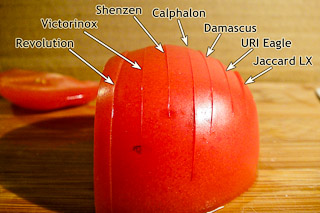 I noticed that cutting performance may be simulated using the depth of various cuts during the Tomato test. This is mostly due to the weight difference between the ceramic knives and steel knives which most likely made this irrelevant in the previous testing done by Michael. However, as shown in this image, the depth of the cut utilizing no weight correlated well with the performance of the knives. (Click on the image for a larger version.)
I noticed that cutting performance may be simulated using the depth of various cuts during the Tomato test. This is mostly due to the weight difference between the ceramic knives and steel knives which most likely made this irrelevant in the previous testing done by Michael. However, as shown in this image, the depth of the cut utilizing no weight correlated well with the performance of the knives. (Click on the image for a larger version.)Note: The Calphalon knife was able to cut deeply but was also significantly heavier than the ceramic knives which is why it did not rank as high.
Scallions test
| Rank | Knife | Notes | |
|---|---|---|---|
| O | 1 | Kyocera Revolution | Clean repeatable cuts with no crushing. |
| E | 2 | Shenzen | Clean cuts were straight and repeatable but required a small amount of force. |
| Kyocera Damascus | |||
| 3 | Victorinox | Did not start as easily but did create clean cuts with a small amount of force. | |
| S | 4 | URI Eagle | Force was required during the cut which caused the scallions to be deform at the beginning of the cut but the end result did not cause the rings to be crushed/broken. |
| Calphalon (Steel) | |||
| U | 5 | Jaccard LX | Force caused the scallions to deform and crush creating broken rings. |
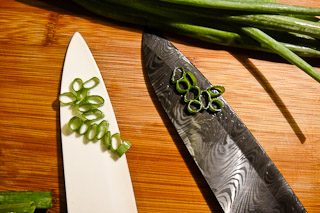
Observations
I encourage everyone to read the other factors section of Michael Chu's article which goes into a number other factors to consider including handle design, overall style, dishwasher safe, feel while cutting, etc. I chose to outline observations that are particular ceramic knives.
The first observation regarding the knives is handle design. I found that most ceramic knives are using a plastic handle which to me seems rather cheap. The Jaccard used a handle that had a rubber feel to it that I liked more than the others. The Kyocera Damascus was the only knife that utilized a handle similar to a steel knife which resulted in a sturdier feeling. I also found that the handle design and angles are rather strange compared to traditional steel knives and would encourage everyone to choose based on their individual preference.
Another observation I made was the tip design. I find this is more applicable to ceramic knives as they are brittle and known for the tip breaking off. The Damascus, Shenzhen, and Victorinox knives had slightly rounded tips whereas the eagle had almost no round. The Revolution had a very rounded tip which I found useful on full cutting motions; I was able to use it almost as a pivot point.
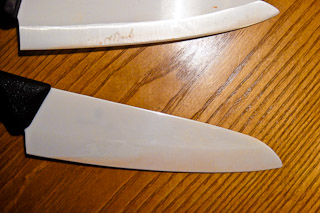 I was very surprised to notice some blade staining from the carrots (see image to the left). The white ceramic knives had a noticeable stain on the bottom edge. This was also surprising because ceramic knives are marketed as less likely to cross contaminate compared to steel knives. The staining was much harder to get off if it dried and on most knives was still slightly visible after scrubbing repeatedly (knives sat for a while after testing and wiping immediately may have prevented this phenomenon). I would recommend purchasing a knife with a darker colored blade so stains are not as apparent.
I was very surprised to notice some blade staining from the carrots (see image to the left). The white ceramic knives had a noticeable stain on the bottom edge. This was also surprising because ceramic knives are marketed as less likely to cross contaminate compared to steel knives. The staining was much harder to get off if it dried and on most knives was still slightly visible after scrubbing repeatedly (knives sat for a while after testing and wiping immediately may have prevented this phenomenon). I would recommend purchasing a knife with a darker colored blade so stains are not as apparent.There is also a noticeable difference between the weight of a steel blade versus a ceramic knife. I believe some users will like this about ceramic knives and some will prefer the weight of a steel blade. I like the weight of a steel knife but personally found this refreshing after using the knives for numerous hours of testing; I believe the lighter blade resulted in less fatigue. Ceramics do require that you provide pressure during the cutting motion which I contribute to the weight difference.
I have attached some images in the Appendix using a 10X magnification of the cutting edges. The Kyocera website marketed their knives as having the straightest edges. These images were taken before using the knives in testing and I am still trying to confirm whether this was a result of them being samples or not. They may be related to the brittleness of the material; the nicks are highlighted in red. There is also little evidence showing a relationship between these defects and poor cutting performance. The nicks are visible by naked eye (although rather hard to see); I would recommend you inspect your knife well before purchasing.
Conclusions
Cooking For Engineers Recommended:
Kyocera Revolution ($53.95)

Best Value (Price for Performance):
Kyocera Revolution ($53.95)
Victorinox ($78.43)
The Kyocera Revolution outperformed all of the other knives tested followed closely by the Victorinox and Kyocera Damascus. Surprisingly, I did not feel that the Kyocera Damascus knife functioned any better than the revolution (and not as well in some instances). At more than double the price, I believe that this knife may be only more appealing due to it's look and not worth the price. The other ceramic knives functioned decently and are considered entry level knives but I do not feel that they are any better than a traditional steel blade. I do not feel that ceramic knives are ready to replace steel knives but find that I would utilize them in certain applications; I personally plan to utilize both.
Appendix
According to Kyocera's website (where you will find magnified images of the edges of example knives), the edges of ceramic knives from different manufacturers can vary.
Related Articles
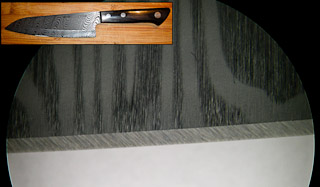
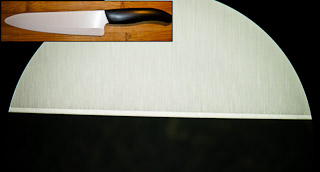
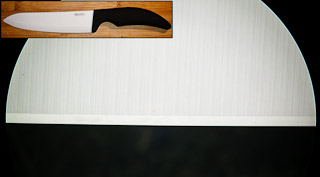
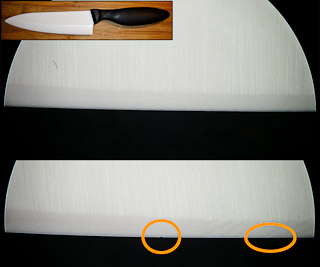
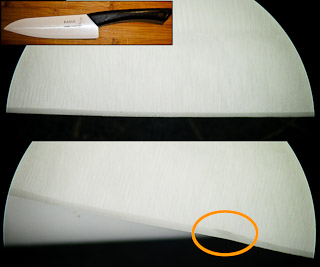
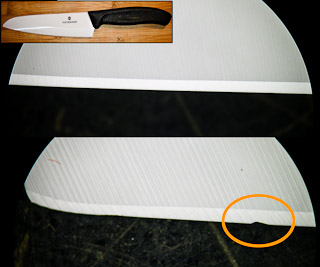

This not only affects grip-to-blade angle, but generally the grind and the cross section of the grind/bevel as well.
I'm curious if it would be possible to repeat the test by isolating the french-pattern and santoku-pattern knives with a steel control for each. Alternatively, giving some description of the edge bevel for each might also provide some insight into the relative chop-versus-slice performance for each blade.
I can see how the tip on a traditional chef's knife might be more prone to breaking, but can't think of any other rationale besides marketing.
I tried a Santoku style once and hated it, yet still want to play with a ceramic some time. I guess a Kyocera paring knife is my future.
Great review -- thanks for the hard work!
Personally, I'd rather have wood handles. It's not like people who buy $50+ ceramic knives do so because they can thrown them in the dishwasher.
Two of them have now chipped endpoints due to accidental dropping. The newest ones have a lot more sharp (different sharpening production tecnique) but also a lot more brittle blades. The oldest one, a Cerastar knife, even if dulled with use and chipped, is still sharp enough to serve everyday usage.
The white blades get stained very easily when you cut artichokes or carrots, and every now and then I clean them with a concentrated bleach solution.
Paring knife, short chef knife, and veg peeler.
They are very light and very sharp. The first week or more that you use it, the light weight of the knife is jarring. I got used to it. Now I switch between ceramic and metal without thinking.
The paring knife is great.
The chef knife is fine, but is quite delicate. I have dropped mine a couple of times and the tip has broken off. It still works, but the lack of tip throws off the balance.
Consider ceramic knives for chopping veg or precision slicing duties.
If you are hacking & prying or cutting up something really heavy (like maybe a pumpkin), stick with steel.
The veg peeler is useless. It just doesn't work.
I also prefer the blade in line with the handle, not perpedicular like the Kyocera.
Paring knife, short chef knife, and veg peeler.
...
The veg peeler is useless. It just doesn't work.
I also prefer the blade in line with the handle, not perpedicular like the Kyocera.
I bought a Kyocera paring knife and Vertical peeler and find I prefer my metal paring knife but just LOVE the peeler. One thing I've learned it that you occasionally need to spray the peeler with Easy-Off and scrub it with a toothbrush, else the ceramic gets sticky and doesn't work as well.
Personally, I'd rather have wood handles. It's not like people who buy $50+ ceramic knives do so because they can thrown them in the dishwasher.
I like also wood handle knives. I felt more comfortable with them. Ceramic handles are ok but I felt its more slippery to handle than the wood handle. Anyway its my only opinion.
B)